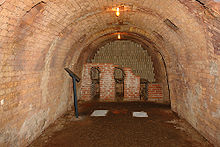Brick factory
A brickworks ( clay works ) is a factory for the production of building materials from masonry bricks . Clay mineral or loam , a mixture of sand and clay , is burned .
details
These companies are usually located at the site of the clay raw material deposits. In the past it was mostly small businesses that pre-dried the still damp bricks in the sun in the open air and then burned them in an oven. Depending on the type of drying, the nearby fuel was necessary as a source of raw material. So not only the location, but the entire infrastructure was based on it. For example, south of Vienna, where there were large clay deposits, the Wiener Neustädter Canal was built to bring the wood from the Vienna Woods . In this case it was the cheapest source of energy. Around 1900 z. B. in the Lausitz area or in the Leipzig area, large brickworks, as there were large clay and sand deposits as a result of the opening of lignite opencast mines and the lignite provided the required energy.
The clay, which is mostly extracted in open-cast mining , is not yet malleable in its raw state and is gradually crushed and mixed in wet or dry processing. The deformable masses are then shaped into masonry bricks , extruded roof tiles , hollow bodies, nowadays mostly industrially with extrusion presses .
Press roof tiles are formed from preformed lumps on turret presses. Floor panels are manufactured using the dry pressing process. The water is extracted in warm air heated drying systems.
The briquettes are placed on kiln cars and fired in continuous furnaces in a process that is precisely tailored to the raw mass at temperatures of around 950 or 1200 ° C ( sinter firing ).
Usually gas or oil is used as fuel. By controlling the oxygen content in the combustion chamber, chemical processes in particular affect the iron oxides in the raw material - oxidizing (red) or reducing (black) fire - the color of the material to be fired.
history
Originally, bricks were burned in field fire brick factories and in shaft kilns . In 1859, the master builder Friedrich Eduard Hoffmann (1818–1900) in Prussia and Austria received a patent on the Hoffmann ring furnace , which gave him the rights to the invention of a ring-shaped furnace for the uninterrupted burning of all kinds of bricks, pottery, lime, plaster and the like secured. The ring kiln revolutionized the brick industry in the 19th century and enabled an unprecedented increase in brick production. Since then, the image of the houses has changed from gray (reed and thatched roof, shrub, wooden, clay walls) to red (roof tiles, brick house, less risk of fire). Brick pipes enable sewerage, as well as underground drainage and drainage of fields.
Today, the various brick products are mainly fired continuously in tunnel kilns. Here, the dried bricks are placed on refractory tunnel kiln cars in a flow-through composite and fired in a defined firing process.
The world's largest brick manufacturer is the Austrian Wienerberger group . The largest manufacturers in Germany are Creaton , Braas and Erlus . In addition to these large manufacturers, there were many medium-sized brick manufacturers, but their number is declining. These include Gebr. Laumans Ziegelwerke and Dachziegelwerke Nelskamp .
All manufacturers are organized in the Federal Association of the German Brick and Tile Industry. The federal association is divided into the professional associations North, Northwest, Southwest, Brick Center South and the Bavarian Brick Industry Association.
Manufactured in a steam brickworks
The following describes the production process in a steam brick at the beginning of the 20th century. Production in modern systems is still essentially the same.

Brick production in a steam brickworks: A. Clay car, coming out of the pit
B. Elevator bridge
C. Elevator
D. Crushing mill
E. Transport trolley, coming from the crushing mill
F. Samps
G. Tonschneider
H. Fine rolling mill
J. Brick press
K. Elevator (elevator)
L. Drying rooms
M. Ring furnace
N. Industrial
steam engine O. Steam boiler
All equipment in a mechanized brick factory used to be powered by steam engines. After the clay had been extracted in the pit near the brickworks, it was fed to the crushing mill on a slope by means of an elevator and elevator bridge. Inside the brick factory, the clay was transported to the swamps, where it was mixed with water and unwanted components such as roots, parts of plants and rubble were washed out. The clay settled as clay sludge on the bottom of the swamps. The cleaned clay was then cut, rolled out and pressed into bricks. The damp bricks were transported to the drying rooms above the ring kiln by elevator. After drying, they were taken to the ring furnace by elevator.
See also
Web links
- Production process in the historic ring kiln of the Gillrath brickworks in Erkelenz
- Gasoline brickworks in Mecklenburg
supporting documents
- ↑ Brick manufacture (Zeno.org)
- ↑ For an example of the operation of a steam brickworks in the Altenkirchen district, cf. Thomas A. Bartolosch: Die Ringofen-Dampfziegelei Christian Sohn, in: Heimat-Jahrbuch des Kreis Altenkirchen 59 (2016), pp. 211-218.



